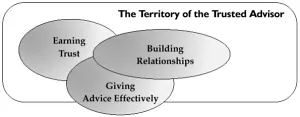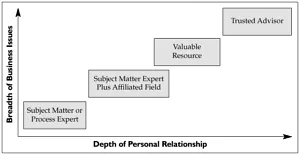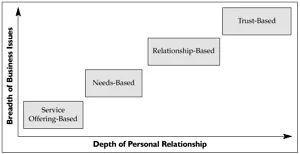![]()
P A R T O N E
PERSPECTIVES ON TRUST
WE BEGIN WITH A BRIEF “sneak preview” of the book’s themes, defining what we mean by the term trusted advisor and exploring the benefits that accrue to trusted advisors.
We then focus on three basic skills that a trusted advisor needs: (1) earning trust; (2) giving advice effectively; and (3) building relationships.
Next we discuss the mindsets or attitudes that are essential to becoming a trusted advisor. In closing, we explore the question of whether building trust is a matter of technique or sincerity (or both).
![]()
1
A Sneak Preview
LET’S START WITH A QUESTION: What benefits would you obtain if your clients trusted you more?
Here’s our list. The more your clients trust you, the more they will:
1. Reach for your advice
2. Be inclined to accept and act on your recommendations
3. Bring you in on more advanced, complex, strategic issues
4. Treat you as you wish to be treated
5. Respect you
6. Share more information that helps you to help them, and improves the quality of the service you provide
7. Pay your bills without question
8. Refer you to their friends and business acquaintances
9. Lower the level of stress in your interactions
10. Give you the benefit of the doubt
11. Forgive you when you make a mistake
12. Protect you when you need it (even from their own organization)
13. Warn you of dangers that you might avoid
14. Be comfortable and allow you to be comfortable
15. Involve you early on when their issues begin to form, rather than later in the process (or maybe even call you first!)
16. Trust your instincts and judgments (including those about other people such as your colleagues and theirs)
We would all like to have such professional relationships! This book is about what you must do to obtain these benefits.
What changes would you make to this list? What would you add? Delete?
Next, let’s consider three additional questions:
Do you have a trusted advisor, someone you turn to regularly to advise you on all your most important business, career, and perhaps even personal decisions?
If you do, what are the characteristics of that person?
If you do not, what characteristics would you look for in selecting your trusted advisor?
Here is a listing of traits that our trusted advisors have in common. They:
1. Seem to understand us, effortlessly, and like us
2. Are consistent (we can depend on them)
3. Always help us see things from fresh perspectives
4. Don’t try to force things on us
5. Help us think things through (it’s our decision)
6. Don’t substitute their judgment for ours
7. Don’t panic or get overemotional (they stay calm)
8. Help us think and separate our logic from our emotion
9. Criticize and correct us gently, lovingly
10. Don’t pull their punches (we can rely on them to tell us the truth)
11. Are in it for the long haul (the relationship is more important than the current issue)
12. Give us reasoning (to help us think), not just their conclusions
13. Give us options, increase our understanding of those options, give us their recommendation, and let us choose
14. Challenge our assumptions (help us uncover the false assumptions we’ve been working under)
15. Make us feel comfortable and casual personally (but they take the issues seriously)
16. Act like a real person, not someone in a role
17. Are reliably on our side and always seem to have our interests at heart
18. Remember everything we ever said (without notes)
19. Are always honorable (they don’t gossip about others, and we trust their values)
20. Help us put our issues in context, often through the use of metaphors, stories, and anecdotes (few problems are completely unique)
21. Have a sense of humor to diffuse (our) tension in tough situations
22. Are smart (sometimes in ways we’re not)
What would you add to (or delete from) this list?
Using the Golden Rule (we should treat others as we wish to be treated), we can probably make a fair assumption (or at least a good first approximation) that this list, or your list, is not much different from a list your clients would make.
So, if you want your clients to treat you as their trusted advisor, then you must meet as many of the “tests” on this list as possible.
Ask yourself: Which of these traits do my clients think I possess? (Not what you think you possess, but what they think you do!) If you suspect that you might not demonstrate all these traits, then how do you get better at each of them? That’s what this book will try to answer.
Note that this book is not (just) about the wonderful benefits that wait at the end of the rainbow for the full-fledged trusted advisor, who does (or is) everything listed here. The early benefits of beginning to earn trust are substantial and can be obtained quickly. The ability to earn trust is a learnable skill, and we shall try in the succeeding pages to show “the yellow brick road” that leads to success.
![]()
2
What Is a Trusted Advisor?
NONE OF US BEGINS our career as a trusted advisor, but that is the status to which most of us aspire. We usually begin as vendors, performing a specific task or “one-off” service, employing our technical skills (see Figure 2-1). We may perform with excellence and expertise, but our activities are limited in scope.
At the next level, the client may sense that we possess capabilities not directly related to our original area of expertise. When operating at this level, we begin to focus on our ability to solve more general problems and not solely on our technical mastery. Our clients see us increasingly this way as well and begin to call upon us for issues with more breadth, and earlier on in the initial defining stages of their problems.
Fig. 2.1. The Evolution of a Client-Advisor Relationship
At the third level (valuable resource) we might be consulted on broad strategy issues related to our specific expertise, but not limited only to that expertise. We are no longer seen through the client’s eyes as having just technical expertise or problem-solving ability, but we are seen in terms of our ability to put issues in context and to provide perspective. We begin to offer advice proactively and to identify issues in their organizational context.
The highest level, the pinnacle, is that of trusted advisor, in which virtually all issues, personal and professional, are open to discussion and exploration. The trusted advisor is the person the client turns to when an issue first arises, often in times of great urgency: a crisis, a change, a triumph, or a defeat.
Issues at this level are no longer seen merely as organizational problems, but also involve a personal dimension. Becoming a trusted advisor at the pinnacle level requires an integration of content expertise with organizational and interpersonal skills.
These levels, depicted in Figure 2-1, are a function of both “breadth of issues” and “depth of personal relationship.” By “breadth of issues” we mean the range of business issues in which the advisor gets involved. By “depth of personal relationship,” we mean the extent to which the client permits us to address their personal relationship to the issues at hand (and the business at large).
We do not suggest that a professional operating at Level 1 is doing something wrong. Far from it. Most of our daily professional lives are spent operating at Levels 1 and 2; relatively little of our time is spent actually working at Levels 3 and 4. The issue is not hours in a day, but rather the ability to shift comfortably and instantly to any level when necessary.
Another way of looking at the stages in the evolution of a client-advisor relationship is shown in Figure 2-2. It uses the same axes: breadth of business issues and depth of personal relationship.
Marketing people are fond of pointing out three kinds of professional-client relationships, which correspond to three approaches to winning business. These are product/service-based, needs-based, and relationship-based approaches. It is usually argued that the best, the most highly evolved of these three types is the relationship-based mode.
We think the distinctions are useful, but the conclusions are not quite right. As we suggested in Figure 2-1, there are times when it is perfectly appropriate and right for a relationship to be service based, or needs-based. And there are times when a particular type of relationship is not the appropriate one.
Fig. 2.2. Four Types of Relationship
Most important, we feel a fourth type of relationship is missing from the typology, the trust-based relationship. The difference between this and the other levels is the human dimension, the recognition of the interpersonal, individual aspects of the relationship.
It can be seen that the full trust-based relationship is marked by a broad range of business issues and a deep personal relationship.
Figure 2-3 summarizes the characteristics of operating at the different levels shown in Figure 2-2. Each level has different implications for the focus, the time and energy spent, for what the client receives from the relationship, and for indicators of success.
Pinnacle Relationships
Extreme examples are often useful for highlighting key aspects of an issue. So it is with pinnacle relationships and trust.
One advisor who has reached the pinnacle of trust with his client is David Falk, agent to basketball superstar Michael Jordan.
Falk helped to create and to build Michael Jordan into one of the world’s most successful “brands,” starting with the 1977 Nike endorsement deal, then worth $2.5 million plus royalties. Eventually, Jordan endorsed dozens of products, from phone service to golf-club covers, and is worth many millions of dollars. Falk, too, has profited handsomely from this relationship. With Jordan as a client, he was able to develop an agency that eventually sold for $100 million.
Henry Louis Gates, Jr., writing in The New Yorker, recounted how Falk was “exquisitely attuned” to Jordan’s attitudes about money and Falk’s fees. In two instances, Falk reduced or waived specific fees (without being asked by Jordan) because he knew that’s what Jordan wanted, even though Michael would never make such a request. Falk believes that this is one of the reasons the two are still working together, and that Falk continues to collect 4 percent of Jordan’s enormous earnings.
The trusted advisor acts variously as a mirror, a sounding board, a confessor, a mentor, and even, at times, the jester or fool. The following excerpt from a conversati...




